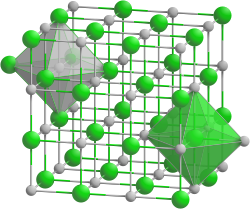Europium(II) oxide

| |
| Names | |
|---|---|
| IUPAC name
Europium(II) oxide
| |
| Other names
Europium monoxide
| |
| Identifiers | |
3D model (
JSmol ) |
|
ECHA InfoCard
|
100.031.497 |
| EC Number |
|
PubChem CID
|
|
CompTox Dashboard (EPA)
|
|
| |
| |
| Properties | |
| EuO | |
| Molar mass | 167.963 g/mol |
| Appearance | Violet crystals[1] |
Except where otherwise noted, data are given for materials in their standard state (at 25 °C [77 °F], 100 kPa).
| |
Europium(II) oxide (EuO) is a chemical compound which is one of the oxides of europium. In addition to europium(II) oxide, there is also europium(III) oxide and the mixed valence europium(II,III) oxide.
Preparation
Europium(II) oxide can be prepared by the reduction of europium(III) oxide with elemental europium at 800 °C and subsequent vacuum distillation at 1150 °C.[2]
- Eu2O3 + Eu → 3 EuO
It is also possible to synthesize from the reaction of europium oxychloride and lithium hydride.[3]
- 2 EuOCl + 2 LiH → 2 EuO + 2 LiCl + H2
In modern research, thin films can be manufactured by
Properties
Europium(II) oxide is a violet compound as a bulk crystal and transparent blue in thin film form. It is unstable in humid atmosphere, slowly turning into the yellow
Europium(II) oxide is
Europium(II) oxide is a semiconductor with a band gap of 1.12 eV.[6]
Applications
Because of the properties of europium(II) oxide, thin layers of the oxide deposited on silicon are being studied for use as spin filters. Spin filter materials only allow electrons of a certain spin to pass, blocking electrons of the opposite spin.[7]
References
- ISBN 3527306730
- ^ ISSN 0021-8979.
- ^ OCLC 310719490.
- S2CID 97016104.
- ISSN 1098-0121.
- ^ hdl:1721.1/39538. Retrieved 2022-01-23.
- S2CID 22764388.
